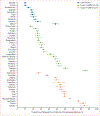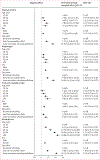Diabetes risk and provision of diabetes prevention activities in 44 low-income and middle-income countries: a cross-sectional analysis of nationally representative, individual-level survey data
- PMID: 37734801
- PMCID: PMC10560068
- DOI: 10.1016/S2214-109X(23)00348-0
Diabetes risk and provision of diabetes prevention activities in 44 low-income and middle-income countries: a cross-sectional analysis of nationally representative, individual-level survey data
Abstract
Background: The global burden of diabetes is rising rapidly, yet there is little evidence on individual-level diabetes prevention activities undertaken by health systems in low-income and middle-income countries (LMICs). Here we describe the population at high risk of developing diabetes, estimate diabetes prevention activities, and explore sociodemographic variation in these activities across LMICs.
Methods: We performed a pooled, cross-sectional analysis of individual-level data from nationally representative, population-based surveys conducted in 44 LMICs between October, 2009, and May, 2019. Our sample included all participants older than 25 years who did not have diabetes and were not pregnant. We defined the population at high risk of diabetes on the basis of either the presence of impaired fasting glucose (or prediabetes in countries with a haemoglobin A1c available) or overweight or obesity, consistent with the WHO Package of Essential Noncommunicable Disease Guidelines for type 2 diabetes management. We estimated the proportion of survey participants that were at high risk of developing diabetes based on this definition. We also estimated the proportion of the population at high risk that reported each of four fundamental diabetes prevention activities: physical activity counselling, weight loss counselling, dietary counselling, and blood glucose screening, overall and stratified by World Bank income group. Finally, we used multivariable Poisson regression models to evaluate associations between sociodemographic characteristics and these activities.
Findings: The final pooled sample included 145 739 adults (86 269 [59·2%] of whom were female and 59 468 [40·4%] of whom were male) across 44 LMICs, of whom 59 308 (40·6% [95% CI 38·5-42·8]) were considered at high risk of diabetes (20·6% [19·8-21·5] in low-income countries, 38·0% [37·2-38·9] in lower-middle-income countries, and 57·5% [54·3-60·6] in upper-middle-income countries). Overall, the reach of diabetes prevention activities was low at 40·0% (38·6-41·4) for physical activity counselling, 37·1% (35·9-38·4) for weight loss counselling, 42·7% (41·6-43·7) for dietary counselling, and 37·1% (34·7-39·6) for blood glucose screening. Diabetes prevention varied widely by national-level wealth: 68·1% (64·6-71·4) of people at high risk of diabetes in low-income countries reported none of these activities, whereas 49·0% (47·4-50·7) at high risk in upper-middle-income countries reported at least three activities. Educational attainment was associated with diabetes prevention, with estimated increases in the predicted probability of receipt ranging between 6·5 (3·6-9·4) percentage points for dietary fruit and vegetable counselling and 21·3 (19·5-23·2) percentage points for blood glucose screening, among people with some secondary schooling compared with people with no formal education.
Interpretation: A large proportion of individuals across LMICs are at high risk of diabetes but less than half reported receiving fundamental prevention activities overall, with the lowest receipt of these activities among people in low-income countries and with no formal education. These findings offer foundational evidence to inform future global targets for diabetes prevention and to strengthen policies and programmes to prevent continued increases in diabetes worldwide.
Funding: Harvard T H Chan School of Public Health McLennan Fund: Dean's Challenge Grant Program and the EU's Research and Innovation programme Horizon 2020.
Copyright © 2023 The Author(s). Published by Elsevier Ltd. This is an Open Access article under the CC BY-NC-ND 4.0 license. Published by Elsevier Ltd.. All rights reserved.
Conflict of interest statement
Declaration of interests We declare no competing interests.
Figures




Comment in
-
National diabetes prevention programmes in LMICs are now a necessity.Lancet Glob Health. 2023 Oct;11(10):e1480-e1481. doi: 10.1016/S2214-109X(23)00381-9. Lancet Glob Health. 2023. PMID: 37734780 No abstract available.
Similar articles
-
Body-mass index and diabetes risk in 57 low-income and middle-income countries: a cross-sectional study of nationally representative, individual-level data in 685 616 adults.Lancet. 2021 Jul 17;398(10296):238-248. doi: 10.1016/S0140-6736(21)00844-8. Lancet. 2021. PMID: 34274065 Free PMC article.
-
Use of statins for the prevention of cardiovascular disease in 41 low-income and middle-income countries: a cross-sectional study of nationally representative, individual-level data.Lancet Glob Health. 2022 Mar;10(3):e369-e379. doi: 10.1016/S2214-109X(21)00551-9. Lancet Glob Health. 2022. PMID: 35180420 Free PMC article.
-
Diagnostic testing for hypertension, diabetes, and hypercholesterolaemia in low-income and middle-income countries: a cross-sectional study of data for 994 185 individuals from 57 nationally representative surveys.Lancet Glob Health. 2023 Sep;11(9):e1363-e1371. doi: 10.1016/S2214-109X(23)00280-2. Lancet Glob Health. 2023. PMID: 37591584 Free PMC article.
-
Folic acid supplementation and malaria susceptibility and severity among people taking antifolate antimalarial drugs in endemic areas.Cochrane Database Syst Rev. 2022 Feb 1;2(2022):CD014217. doi: 10.1002/14651858.CD014217. Cochrane Database Syst Rev. 2022. PMID: 36321557 Free PMC article.
-
Interventions for preventing type 2 diabetes in adults with mental disorders in low- and middle-income countries.Cochrane Database Syst Rev. 2021 Feb 16;2(2):CD013281. doi: 10.1002/14651858.CD013281.pub2. Cochrane Database Syst Rev. 2021. PMID: 33591592 Free PMC article.
Cited by
-
An unbiased, sustainable, evidence-informed Universal Food Guide: a timely template for national food guides.Nutr J. 2024 Oct 18;23(1):126. doi: 10.1186/s12937-024-01018-z. Nutr J. 2024. PMID: 39425106 Free PMC article. Review.
-
Role of Abscisic Acid in the Whole-Body Regulation of Glucose Uptake and Metabolism.Nutrients. 2024 Dec 24;17(1):13. doi: 10.3390/nu17010013. Nutrients. 2024. PMID: 39796447 Free PMC article. Review.
-
Prediabetes.Nat Rev Dis Primers. 2025 Jul 17;11(1):49. doi: 10.1038/s41572-025-00635-0. Nat Rev Dis Primers. 2025. PMID: 40676018 Review.
-
Improving the quality of chronic care through purchasing arrangements in resource-constrained settings: insights from an international Delphi survey.Glob Health Action. 2025 Dec;18(1):2518667. doi: 10.1080/16549716.2025.2518667. Epub 2025 Jul 3. Glob Health Action. 2025. PMID: 40607747 Free PMC article.
-
Exploring prediabetes remission in public primary care in Mexico: A cascade analysis.Clin Med (Lond). 2025 May;25(3):100310. doi: 10.1016/j.clinme.2025.100310. Epub 2025 Apr 3. Clin Med (Lond). 2025. PMID: 40187414 Free PMC article.
References
-
- Bommer C, Sagalova V, Heesemann E, et al. Global economic burden of diabetes in adults: projections from 2015 to 2030. Diabetes Care 2018; 41: 963–70. - PubMed
-
- International Diabetes Federation. IDF Diabetes Atlas, 10th edn. Brussels: International Diabetes Federation, 2021.
Publication types
MeSH terms
Substances
Grants and funding
LinkOut - more resources
Full Text Sources
Medical

